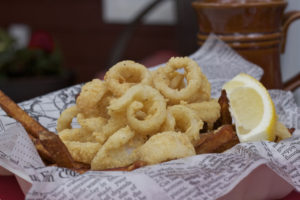“Knowledge is power and food taste better when you know more about what you’re eating. It’s quite personal what you put in your mouth!”
Capt’n Kenny
- Is Calamari the same as Squid?
- Do they taste the same?
- Are they different animals?
- Is Calamari an Octopus with a tail?
- How do I know which one to buy?
- What in the world…?
This week we will go into the deeps of the ocean and find out the truth about Calamari…or squid…or cuttlefish…or octopus! Read on!
According to Wikipedia:
“The English name calamari has been borrowed multiple times, first from Spanish calamar, later from Italian calamaro, and most recently from Modern Greek καλαμάρι kalamári. All derive from the Late Latin calamarium, “pen case” or “ink pot”, itself from the Latin calamarius, “pertaining to a writing-reed”, after the resemblance in shape and the inky fluid that squid secrete; calamarius, in turn, derives from the Greek κάλαμος kalamos ‘reed’ or ‘pen’.”
Anyone who has ever fished for Squid knows what the ink is all about! Watch this short video:
Despite the many claims going around that squid and calamari are different, that “one is more tender than the other”, “The fins on one are shorter than the other” or “they are different in color”, squid and calamari are pretty much the same. YES! at least biologically.
Squids (or calamari, or even cuttlefish) are typically marine cephalopods mollusks (like the octopus) belonging to the Loliginadae family. (Try saying that one five times fast!!) The main difference is that these Cephalopods vary in size from very small to gigantic many feet long monsters that live in the deeps of the ocean and surface from time to time. These giant ones are not suitable for eating as they have a strong taste of ammonia but the smaller varieties are more tender to cook and the ones you should buy. The ones with shorter fins, commonly belonging to the Loligo or the Gould’s squid variety, are smaller and are considered finer. They are more expensive too.
So, how do we know what to buy?
Buying Calamari, or squid, same thing, could be tricky. General guidelines we need to follow are:
- The smaller the size, the more tender it will be.
- Fresh squid is easier to identify than frozen, so try to buy fresh. However, if the frozen bag is identified properly, go for the frozen, it is usually fresher.
- If you are able to identify the variety, go for Loligo or Gould’s squid. These are great! They are tender and easier to cook.
- The Fishmonger should be your best friend. They know what they have in the counter and should be able to direct you to the best Calamari.
- The best way to buy it is when it is already clean, but if you can’t find it clean, the cleaning process is not complicated, so get it anyway. Just know you will need to separate the tentacles from the tubes and empty the tubes including taking out the cuttlebone, which is the plastic-like soft blade that looks like a feather. Chop the tentacles off and discard the rest of the head including the beak (the hard part that looks like a white parakeet beak). Most of the times the skin is already off but if it is not, just peel it by softly ripping the out layer of the skin until it is white. Some people find this process really gross and use gloves. I don’t really have a problem with it.
Do you have any other tips? Let us know in the comments! 🙂
There are many health benefits from eating Calamari or Squid. Among the benefits, they provide Copper, Selenium, Zinc, and they are a very good source of vitamin B12 and B3. They are also a great source of protein.
Now, let’s talk about our favorite part, cooking calamari!
A popular calamari dish in Spain is ‘Black Rice’, also called ‘Calamares en su tinta’ (Calamari in its own ink), which is the squid cooked with Paella rice in its own ink that makes for delicious black rice. Italians call it ‘Risotto Nero’ and it is scrumptious!
The Spaniards also add Calamari rings to their famous Paella Mixta, which is a mix of seafood (shrimp, clams, scallops, squid), chicken and sausage in rice and vegetables perfumed with saffron. They cook it in a big pan and put it on a grill, make a party while the Paella is cooking, they drink a lot of yummy wine and when ready, they sit and enjoy! For those who don’t like to mix seafood and meat, there is the Paella Valenciana from the Valencia region of Spain that is only prepared with seafood. But that is material for another blog post! Let’s talk about calamari here!
Squid or calamari, however you want to call it, is prepared all around the world in many different ways. In most regions of Europe and especially around the Mediterranean, going from Greece to Turkey and down to Spain and Portugal, people cut it in rings, batter it and fry it, or grill it with vegetables topped with some spicy Peri Peri sauce like in Portugal. In New Zealand, Australia and South Africa, it is sold in fish & chips joints. In the Philippines, they cook it with savory adobo sauce along with its ink or they grill it brushing it with a Soy sauce based marinade. Going through Asia, you would find it in stir-fry, noodles and rice dishes, sometimes heavily spiced.
Different from its Australian and New Zealand counterparts, at Capt’n Kenny’s Fresh we prepare it breaded and fried, the European way, with one of our crazy dips, but with a difference. Capt’n Kenny uses the Loligo variety and cuts the tubes in curls instead of rings. This is not a very common technique and there is a secret for that which he explains in this week’s Capt’n Galleys video
There are three main ways of preparing squid:
- Fried battered, which is the easiest way.
- Grilling or sautéing on high heat for around three minutes.
- Braising or boiling on low heat for about 45 seconds until opaque.
One thing for sure, overcooked squid feels like rubber. So, be mindful of the cooking time.
So, let us know your thoughts and leave us any questions down in the comments. We will be happy to answer them! Happy squid cooking! 😀


I have read your entire article, hoping to get my question answered. How can I determine/know the difference between Calamari and Squid? You say (despite the claims) they are pretty much the same. I was told that the squid is tougher, and the piece I had was very… I have had calamari, and it was tenderer. But, I don’t know how to tell/know the difference when purchasing it fresh, to cook at home. I want to know what I’m looking at/for. My preference is calamari. Also, where can I purchase them? The super markets I stopped in told me they don’t carry them.
Would really appreciate your help!!!
Thanks!
Hi Betty, Thank you for your question and note! The difference has nothing to do with the name. “Calamari” means “squid” in Italian. However, depending on the size and species of the squid, it will be more tender or better tasting. Most of the times if you go to a supermarket, unless the person behind the sea department knows what they are doing, they would be able to tell you what kind of squid they are selling. The problem is that some times distributors sell the best squid to restaurants at a better price and in greater quantities. Depending on where you live, you should be able to find a specialized store where you could buy one of the best varieties like Loligo or Gould’s. Next time you go buying squid, or Calamari, ask for the Loligo (Loh-lee-go) variety at a seafood specialized store and you should be able to find it. Also, another way to tell the squid is tender is by the size, the smaller, the more tender. Thanks again and let us know if you found it!
in italiano squid e la seppia che non e un calamaro